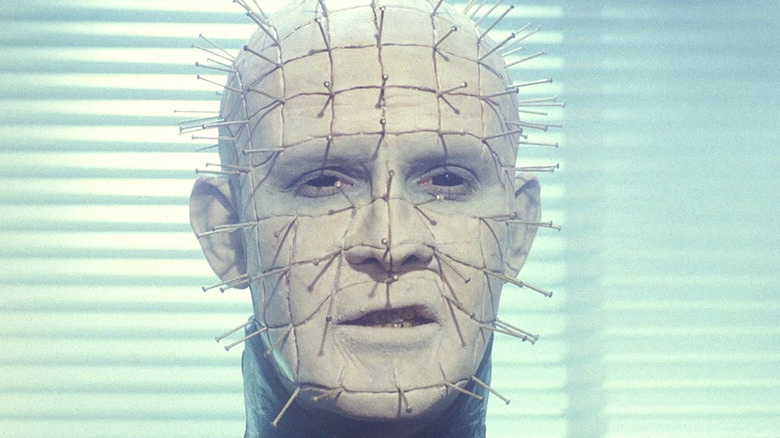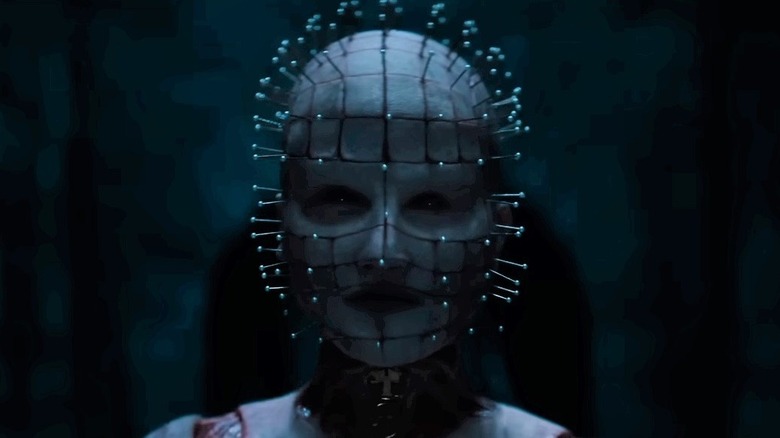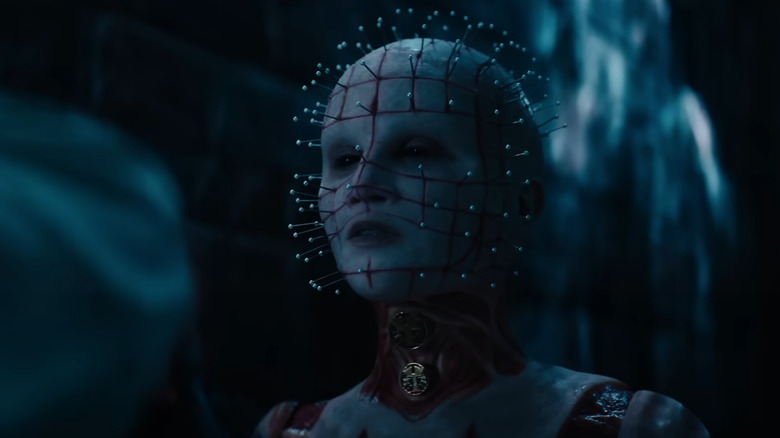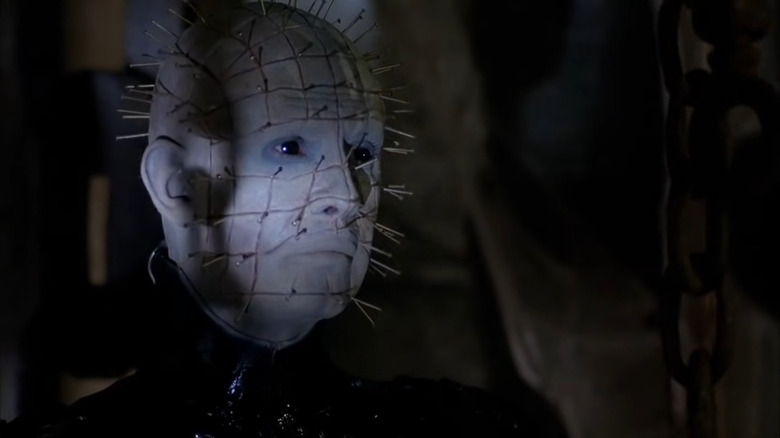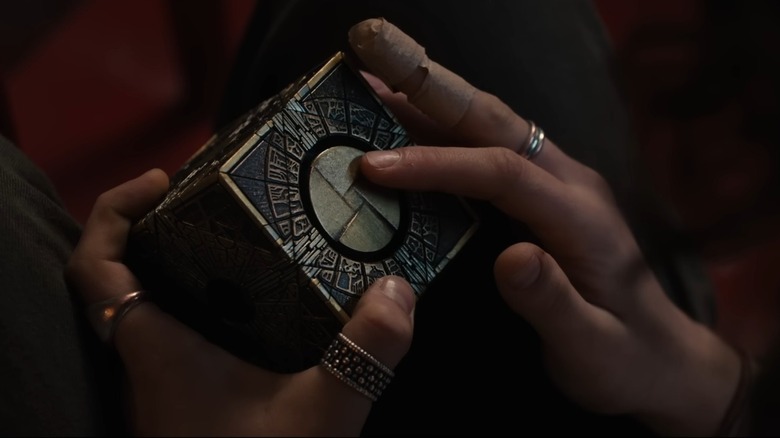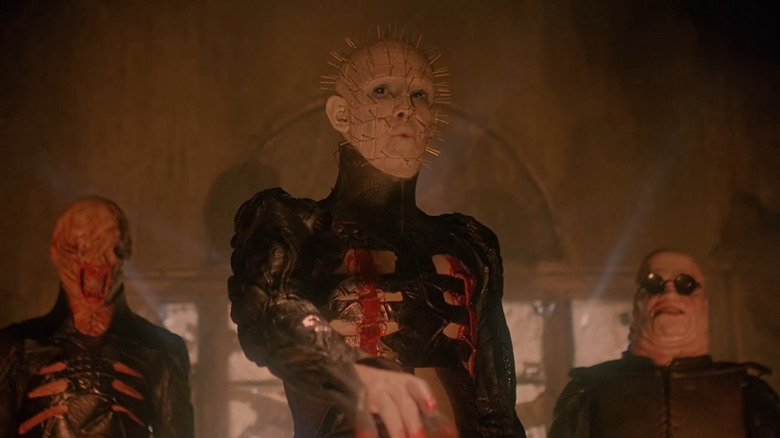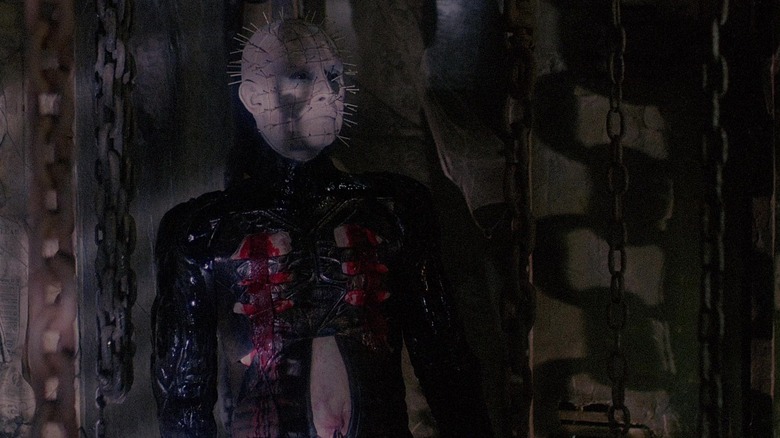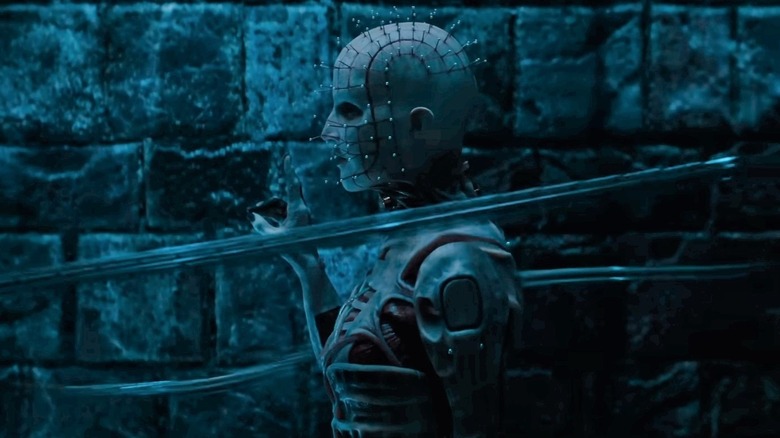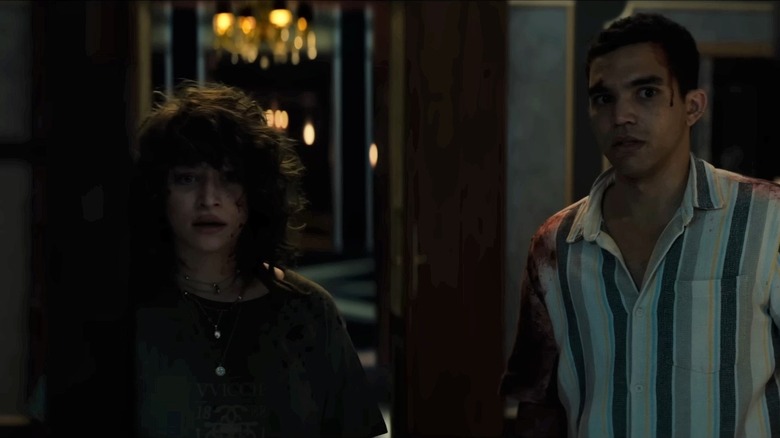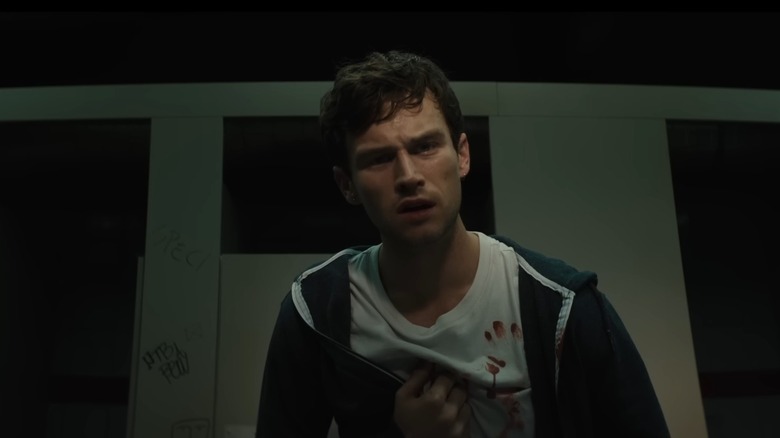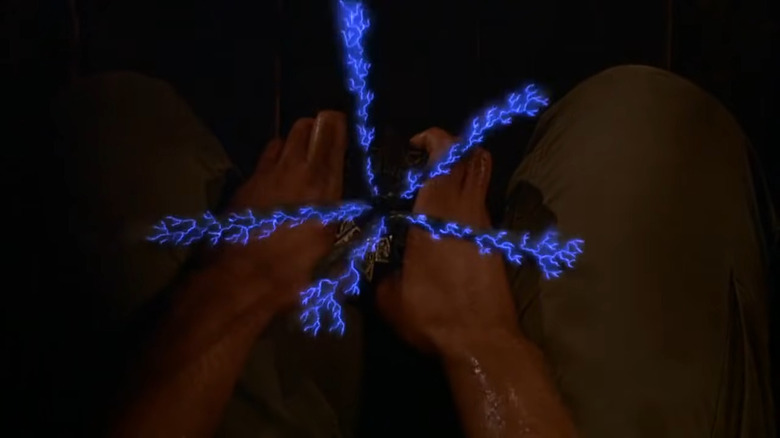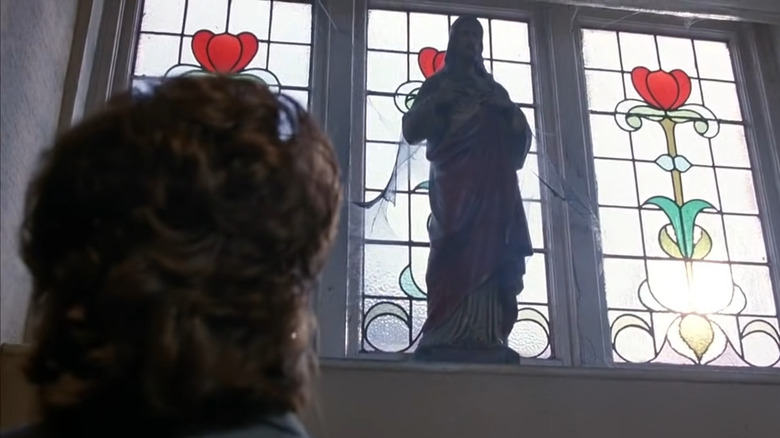Pinhead's Biggest Differences Between Hulu's Hellraiser And The 1987 Original Film
This post contains spoilers for "Hellraiser" (2022).
"Hellraiser" is one of the most recognizable horror franchises in the world today. While the story started out as a horror novella from British author Clive Barker, it ascended to the next level of popular culture thanks to the 1987 film written and directed by Barker himself. In the film, Doug Bradley portrayed the main Cenobite, who has become affectionately known as Pinhead due to the Hell Priest's prickly appearance. Bradley has become as synonymous with the character as Robert Englund has with Freddy Krueger. However, time stops for no one, so it was always likely the role would be recast somewhere down the line. Both Stephan Smith Collins and Paul T. Taylor portrayed the character once each in a film, while Jamie Clayton became the latest actor to take on the role of Pinhead in Hulu's 2022 "Hellraiser."
Directed by David Bruckner, with a story from Ben Collins, Luke Piotrowski, and David S. Goyer, the 2022 version of "Hellraiser" is the 11th entry in the franchise. However, it serves as something of a soft reboot as it tries to reimagine the premise — and Pinhead — for a new generation of fans. Naturally, there will be comparisons between Clayton and Bradley's portrayals of the lead Cenobite, as they share similarities but also differ greatly. So let's take a look at Pinhead's biggest differences between Hulu's "Hellraiser" and the 1987 original film.
Pinhead's first appearance in Hulu's Hellraiser is delayed
The delaying of gratification sounds like something Pinhead would encourage everyone to do, in order to keep the climax (of pleasure or pain) that more special. In 1987's "Hellraiser," though, the Hell Priest appears as soon as Frank Cotton (Sean Chapman) solves the puzzle box and unleashes an insurmountable amount of pain on himself. The Cenobites traverse into the picture along with their mysterious robed leader, as Frank becomes the living (but not for long) embodiment of the Natalie Imbruglia song "Torn."
Conversely, Hulu's "Hellraiser" doesn't reveal the Cenobites until Riley solves the puzzle box and welcomes Pinny and the gang into her world, which is roughly 30 minutes into the film. While the beginning of the movie does share a smidgen of similarities with the original in the sense that it shows the sheer evil the box possesses inside, it stops short of showing the horrific beings from the other dimension. It's an effective technique that many horror films employ as they keep the audience petrified of the monster lurking in the shadows rather than showing them in their full glory right away. By the time Pinhead and the rest of the Cenobites show their beautiful demonic faces in this film, the audience has already been thoroughly creeped out twice.
Pinhead appears more in Hulu's Hellraiser
It's funny how most people think of 1987's "Hellraiser" and the first thing that comes to mind is the Cenobites. From a visual point of view, it makes sense, since their designs are unique and eye-catching; however, their influence on the story is largely as ominous presences looming over proceedings rather than as active participants. In fact, "Hellraiser" is more about Frank convincing his brother's wife, Julia (Clare Higgins), to help him restore his regular appearance by feeding him victims. The Cenobites feature mostly in the film's opening scene and then again in the third act, but they aren't as in-your-face as some viewers might remember. According to director and writer Clive Barker's comments to The Guardian, Pinhead is only in the film for eight minutes in total.
Hulu's "Hellraiser" makes Pinhead and the hellish crew a part of the action as soon as they're introduced in the story by Riley solving the puzzle box. Down every dimly lit alleyway, in every shadowy part of town, the Cenobites are there, and they aren't looking to play "Monopoly" with Riley and her friends, that's for sure. While there may be an argument from some that Pinhead and the otherworldly peeps are overused in the new film compared to the original, "Hellraiser" understands the fans have come to see the Cenobites and their carnage and more than delivers in terms of their screen time.
Pinhead's voice is different
Everyone wonders what a demonic voice from hell might sound like. For some, it could be a screeching banshee-like noise that pierces the eardrums and bleeds the ears, while others might perceive it to be the voice of a telemarketer who doesn't know when to quit and bores the person into a hypnotic daze. Well, both versions of "Hellraiser" provide their own interpretations of what the Hell Priest sounds like. In 1987's "Hellraiser," Pinhead sounds masculine and has a British accent, which should come as no surprise since actor Doug Bradley is all of those things. Bradley's voice is highly distinct and he has even provided narration to a few of extreme metal band Cradle of Filth's albums.
Whereas in Hulu's "Hellraiser," Jamie Clayton's Pinhead possesses a more feminine and modulated voice — it's as if Clayton uses Batfleck's masked voice from "Batman v Superman: Dawn of Justice." In "The Hellbound Heart," the Clive Barker novella that inspired "Hellraiser," the author wrote the Hell Priest's voice "was light and breathy — the voice of an excited girl." While Clayton's Pinhead might not have come across as overly excitable and had a more sinister quality to the tone, her voice shares more in common with the source material's description than Bradley's pipes do.
Pinhead doesn't reset the puzzle box
The rules of the Lament Configuration, aka the puzzle box, are a little fuzzy in the "Hellraiser" universe. With so many movies and stories released, it's expected that there will be changes made to how it works and what are the parameters around its usage, depending on the filmmaker's desired interpretation. In Hulu's "Hellraiser," it's clear this version of the puzzle box is different from the previous incarnations and is far more mystical than it appears. By the looks of it, the Cenobites have a higher degree of control over it, too, being able to influence the configuration without having to touch it.
In 1987's "Hellraiser," Frank Cotton fiddles with the box and unlocks his doom. After Frank's torture, the box lies there in the same position in which Frank configured it until Pinhead arrives and resets it by hand. In the new version of the film, the box resets itself in Riley's hands while she speaks to the Cenobites at the end of the story. It begs the question: Can the puzzle box be configured by the mind or some other invisible force? If so, it's easy to see how sneaky the Cenobites could be in setting someone up to the configuration (and punishment) of their choice.
Pinhead's dress sense isn't Goth chic anymore
When it comes to the best-dressed horror villains around, there really isn't much competition here. Freddy Krueger wears an old, faded sweater and a ratty fedora that hasn't seen a washing machine in its life. Michael Myers isn't exactly a snazzy dresser either, looking more like he's coming to fix the telephone line than he is to stab people. However, Pinhead has always stood out. The 1987 version of the character demands everything in black, wearing a skintight leather dress that hugs the figure and the acupuncture needles that haven't been removed from the head. It's like the official uniform of every industrial rock band such as KMFDM and Rammstein who lather themselves in the BDSM culture.
Hulu's "Hellraiser" maintains the dress and pins from before, but removes the jet-black aesthetic. It also makes it tough to differentiate what is clothing and what isn't. Pinhead has a fleshier and android-like appearance here, as it looks like the flesh has been peeled back to reveal the muscles beneath the surface. Whereas the original film version of the character had more of a Gothic or industrialized design, the new version leans heavily into the horror aspect of the character — almost making it uneasy to even lay eyes on Pinhead.
Pinhead is more in line with the source material in Hulu's Hellraiser
While Hulu's "Hellraiser" is deemed a soft reboot, it can also easily be considered a continuation of the series since it doesn't try to retread the same ground as the original movie. It doesn't even bother to retell the story of the Cotton family, as it focuses on a new group of victims characters. In the case of Pinhead, though, this latest version of the villain is more akin to the character created in Clive Barker's "The Hellbound Heart." The lead Cenobite is more androgynous in appearance, while the voice leans on the feminine side — both qualities the author alluded to when describing the being in the novella.
At the same time, director David Bruckner has pointed out that this version of Pinhead and Hulu's "Hellraiser" is simply the filmmaker's interpretation of the character and story, but there are no right or wrong versions. Speaking at a press event about the film (via Gizmodo), Bruckner stated: "I'm a big believer that, you know, movies are dreams and sometimes they present strange iterations of one another, and that we should just embrace that and kind of run with it. My suggestion to fans is to go into it not thinking exactly where it's fitting in the history of the series and to just experience the film."
Pinhead destroys another Cenobite
Most fans see the Cenobites as horror's Goonies. These hellish creatures get up to a host of mischief, but they always stick together like a band of f(r)iends. For better or worse, they can rely on one another since they operate as a singular unit. In fact, the other characters in 1987's "Hellraiser" could learn a thing or two from the Cenobites in terms of loyalty, because they don't sell each other out or switch allegiances as soon as the wind changes direction.
In Hulu's "Hellraiser," the beings are still glued at the hip, but they also respect the rules of their own demented game about pleasure and pain — well, at least among one another. When Riley stabs Chatterer with the puzzle box's blade, the creature seems to understand what comes next. It steps back and stands still, with its arms wide open and inviting its impending fate. Pinhead doesn't bat an eyelid, either, as the Hell Priest summons the chains and tears Chatterer to pieces. It's a brutal scene that demonstrates how wicked the Cenobites can be, though it's to be expected. If they are dealing in pain, surely they would dish it out to one another in equal doses too, right?
Pinhead doesn't negotiate or reason
The world of horror needs to move past the sympathetic villain trope. If someone is chasing other people around with a knife or machete or summoning interdimensional chains to tear limbs apart, there really is no reason to discover which childhood incident led the person to do such terrible deeds. They're simply bad people. More importantly, the film shouldn't try to portray the rogue as potentially nice or reasonable, depending on if the right person connects with them. This is how we get people falling in love with the likes of Jeffrey Dahmer or fictional characters like the Joker, believing they can change them and leading to a whole host of new societal problems.
In the original "Hellraiser" film, Kirsty Cotton is able to reason with Pinhead and the Cenobites, trading her uncle Frank for her own safety. Perhaps the Cenobites feel sorry for Kirsty in the moment or they want to slice and dice Frank more — regardless, Kirsty is able to save her own hide by appealing to reason and putting a new offer on the table. In Hulu's "Hellraiser," the rules are the rules, and they're always made clear from the start. If someone wants to escape the Cenobites, they need to sacrifice someone else in their stead. Even so, Pinhead and the crew aren't willing to sit around and negotiate terms. Either the person accepts their demands or they get ripped apart. No middle ground here.
Pinhead loves to show off the torture in Hulu's Hellraiser
While the Cenobites position their gifts as either pain or pleasure, everyone knows the truth here: It's all about the pain. They love nothing more than to abuse their victims and leave them begging for their lives to end. Yet, there's a key difference between how Pinhead and the Cenobites torture their victims in the 1987 film and the Hulu movie. Seemingly, the originals don't appreciate voyeurs taking a peek while they do their work, as they prefer it to be a more personal and intimate experience.
In 1987's "Hellraiser," Kirsty hangs around as the Cenobites are about to lay the smackdown on Frank. Naturally, there's a morbid curiosity from Kirsty about what they're about to do to her uncle and how they'll do it. Pinhead, though, snaps back at her: "This isn't for your eyes," indicating they aren't too keen on broadcasting the torture to her. On the other hand, Hulu's "Hellraiser" demonstrates the Cenobites destroying anything and everyone in their path, and they aren't too concerned about who sees it. In fact, it looks like they get some kind of glee from others witnessing their devastating handiwork. It's like a free PPV for whoever is in the vicinity, a grotesque blend of torture and performance.
Pinhead's puzzle box doesn't shock in the new film
The puzzle box in "Hellraiser" is certainly no Rubik's cube — regardless of which version of the film the viewer is watching. It's a devious, little creation that's meant to cause a magnitude of suffering and pain to those who fiddle with it. In 1987's "Hellraiser," as soon as a configuration is unlocked, there's a sudden shock and spark from the box, as hooks extend from it and sink into the user's skin. Case in point: Look at Frank, who had absolutely no chance of survival when he configures it. In theory, though, all it takes is the person turning the right combination and that's it; the person is a goner before they even know it.
Hulu's "Hellraiser" actually offers the user a semblance of a chance at survival. There are various configurations, but the puzzle box doesn't spark or shock like in the original film. Instead, a hidden blade shoots out of it. If the blade cuts the user, the blood spills onto the box and that activates the configuration. That being said, as long as the person avoids the blade altogether, they'll be okay since the disastrous sequence won't be fully activated. Ideally, if someone really wants to play with the puzzle box, they should really invest in robotic arms here, in order to avoid any potential accidents or triggering their own personal apocalypse.
Pinhead isn't surrounded by religious iconography
Remember the time in horror when religious elements were everywhere? From "The Exorcist" to "The Omen," religious subtexts or symbols played a major part in many storylines. While 1987's "Hellraiser" doesn't exactly center around a battle between the armies of heaven and hell, it does boast religious iconography throughout several sequences. Statues of Jesus and other Christian symbols appear in the Cotton household, with even Frank Cotton uttering the phrase "Jesus wept" from the book of "John," chapter 11, verse 35.
However, Hulu's "Hellraiser" stays away from religious subtexts as much as it can. While it's clear the Cenobites are demon-like beings from another dimension, the film largely avoids including any type of specific religious allusions to them being the forces of Satan or anything. This isn't exactly a new trend, though, as there has been a noticeable drive in major pictures to move away from focusing solely on Judeo-Christian beliefs as the baseline for storytelling, in an attempt to be more diverse and inclusive of different belief systems and other religions. At the end of the day, the premise for "Hellraiser" isn't impacted by this filmmaking choice at all, since it's still about a group of Cenobites wreaking havoc on anyone who unlocks their harrowing puzzle box.
